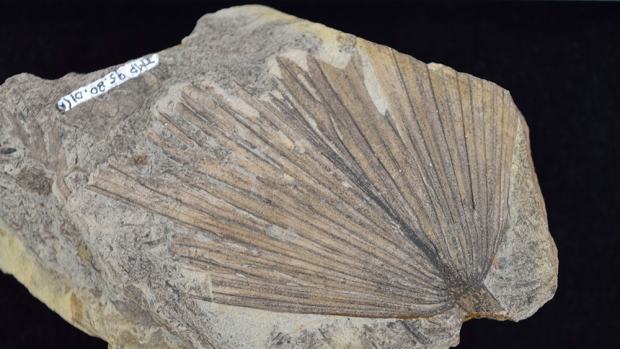@WFS,World Fossil Society,Riffin T Sajeev,Russel T Sajeev
@WFS,World Fossil Society,Riffin T Sajeev,Russel T Sajeev
A researcher identified a new species of small palm that once grew in Canada after examining a fossil that had been part of an Alberta museum collection for decades.
Palms are typically associated with warm, tropical climates. However, this newly discovered fossil indicates that palms grew much farther north than previously thought east of the Rockies.
‘We see palms and we think, ‘Oh! It was tropical!’ Well, maybe not.’– David Greenwood, Brandon University
The finding also indicates that palms existed in temperate (rather than tropical) climates 20 million years earlier than records previously suggested.
David Greenwood, a biology professor at Brandon University in Manitoba, found the palm in the collection at the the Royal Tyrell Museum. The Drumheller, Alta., museum had held the fossil since scientists collected it in 1995.
The finding is significant for several reasons, he told CBC News.

This palm fossil, found near Edmonton, suggests that palms lived in western Canada at a time when the climate was more temperate. (David Greenwood)
“It’s got two different levels of specialness: one, just the scientific interest of palms as climate records, but also, hey, we had palms in Canada!”
Once Greenwood examined the fossil, he determined that it had come from the Paleocene era, about 65 million years ago.
But the finding of an ancient palm fossil — which is only about the size of an average person’s hand — doesn’t mean Edmonton was necessarily a tropical paradise at that time. It was more of a temperate area with pine, birch, cedars and other deciduous trees. The climate, Greenwood said, would have been more akin to that of southern Ontario: cold in the winter, without lingering snow, and wet in the summer.
“We see palms and we think, ‘Oh! It was tropical!'” he said. “Well, maybe not.”
@WFS,World Fossil Society,Riffin T Sajeev,Russel T Sajeev
@WFS,World Fossil Society,Riffin T Sajeev,Russel T Sajeev
A changing climate
Greenwood has been studying palm fossils and warm climates since 1993. He says that adult palms have been found to be quite resistant to limited cold weather, while seedlings can’t survive at all. So, if we begin to see palm trees survive in areas where it’s typically too cold to grow, it is a good indicator of a changing climate.
“They’re the canaries in the coal mine, because they’re quite sensitive to the warmth and the cold,” he said.
Studying fossils from a time when Earth was undergoing a major transition in climate helps scientists better understand the currently changing climate.
“Palms are a harbinger of what’s coming.”
Greenwood would like to go back to where the palm was found, about 18 kilometres southwest of Edmonton.
“There are still a lot of things we don’t know about this little palm … we might even find seeds.”
There have been previous palm fossil finds in Alberta from the Cretaceous era and some from the Eocene found in coastal regions and the interior of B.C.
But Christopher West, a doctoral candidate from the University of Saskatchewan who worked on the project, said in a release that “Paleocene palm fossils were always missing in Canada though, and this research helps to fill in some of the gaps in the palm fossil record.”
@WFS,World Fossil Society,Riffin T Sajeev,Russel T Sajeev
Courtesy: CBC news
Key: WFS,World Fossil Society,Riffin T Sajeev,Russel T Sajeev



 January 22nd, 2017
January 22nd, 2017  Riffin
Riffin  Posted in
Posted in  Tags:
Tags: 